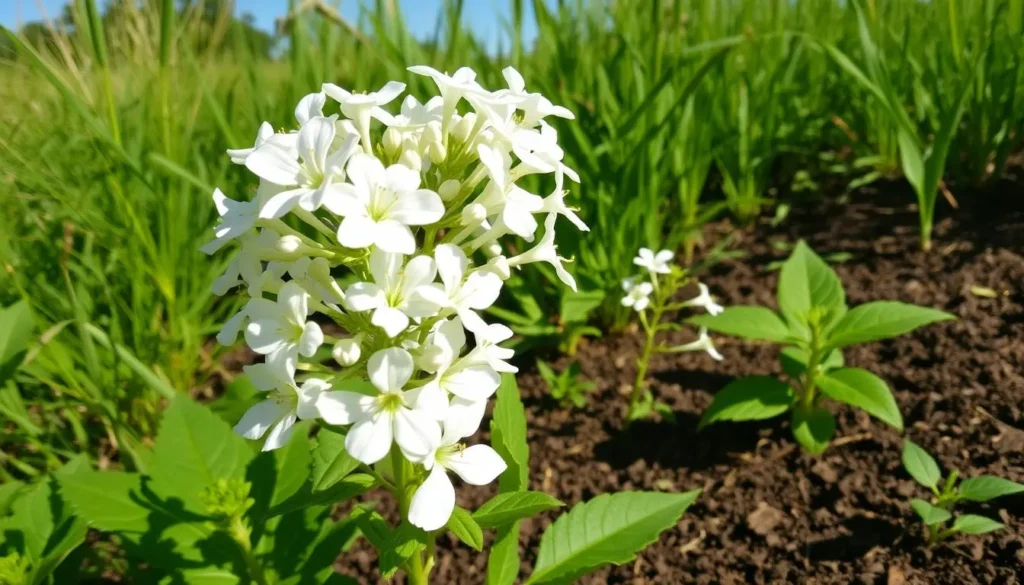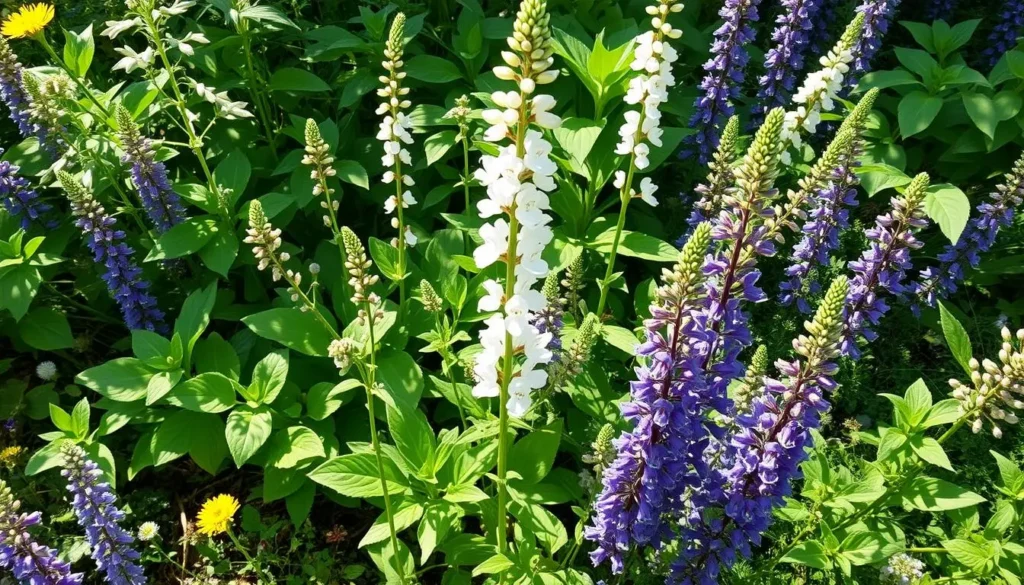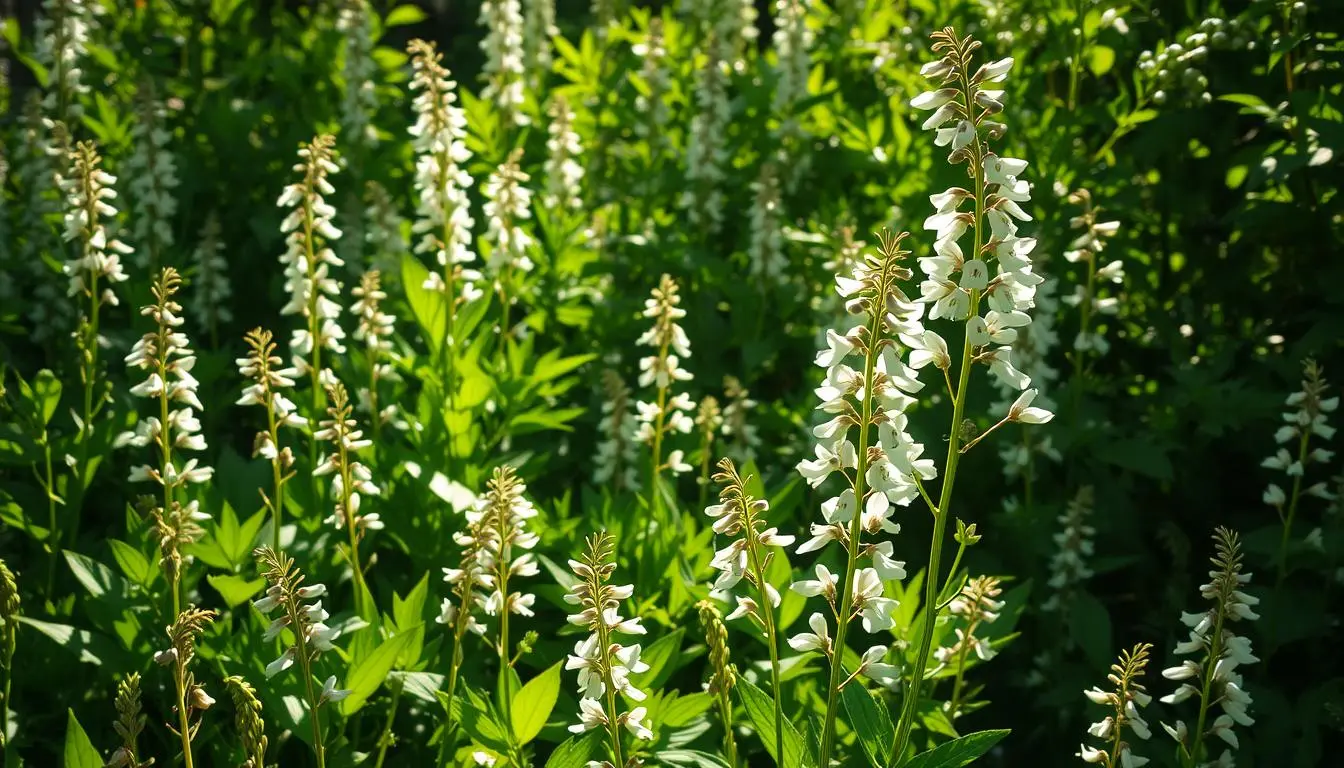I love gardening and always look for native plants. The White Wild Indigo caught my eye. It’s a perennial from North America and a gem in my garden. Its white flowers and strong leaves are beautiful and show the beauty of native plants.
This guide will dive into the White Wild Indigo’s history, looks, and benefits. It’s perfect for anyone who loves plants. This native plant will make your garden special.
Table of Contents
Introduction to Baptisia Alba: A Native American Beauty
Baptisia alba, also known as white wild indigo, is a stunning native American plant. It has a long history in the culture and traditions of indigenous peoples in North America. This perennial herb is known for its white flowers and green leaves. It has been valued for its many uses and interesting past.
Historical Significance in Native American Culture
The Baptisia alba plant is highly respected by many Native American tribes. It is known for its healing properties and cultural importance. The roots and leaves were used in traditional medicine. The roots helped with digestion, the leaves were used for blue dye, and in textiles.
Natural Habitat and Distribution
- The baptisia alba plants are found in the central and eastern United States. They grow well in prairies, open woodlands, and by roads.
- This native American plant ranges from the Great Plains to the East Coast. Its main white wild indigo habitat is the tallgrass and shortgrass prairies of the Midwest.
- Baptisia alba is key to keeping prairie ecosystems balanced and diverse. It provides food and shelter for many native wildlife species.
Baptisia alba is a symbol of the natural beauty and strength of North America. Its rich history, cultural value, and role in the environment make it truly special.
“The white wild indigo is a testament to the enduring spirit of the native plants that have shaped the land for centuries.”
Physical Characteristics of White Wild Indigo
The Baptisia alba, also known as the white wild indigo, is a captivating perennial native to North America. This herbaceous plant boasts several distinctive features that make it a true standout in the garden.
One of the most striking characteristics of the Baptisia alba is its trifoliate leaves. The plant’s deeply lobed, bluish-green leaves are arranged in a clover-like pattern, creating a lush, textured foliage. As the plant matures, the baptisia alba leaves transform, developing a glaucous hue that adds to its visual appeal.
The true showstopper of the Baptisia alba, however, is its striking white flower spikes. Emerging in late spring or early summer, the white wild indigo flowers bloom in tall, upright clusters, creating a dramatic display. These perennials can reach up to 3 feet in height, making them a captivating addition to any garden.
As the growing season progresses, the Baptisia alba undergoes a remarkable transformation. The plant’s foliage and flowers give way to distinctive seed pods, which turn from green to black as they mature. This unique lifecycle adds to the plant’s visual interest and makes it a compelling choice for gardeners and nature enthusiasts alike.
“Baptisia alba is a true staple of the native plant garden, offering a unique and captivating display throughout the seasons.”
Benefits of Growing Baptisia Alba in Your Garden
Native plants like Baptisia alba, or white wild indigo, can make your garden better and more eco-friendly. This plant is great for attracting wildlife and adding beauty to your outdoor space.
Environmental Benefits
Baptisia alba grows well in many soils, making it perfect for green gardening. It fixes nitrogen, which makes the soil healthier. Its deep roots also stop soil from washing away, keeping your garden safe.
Aesthetic Value
This plant has beautiful blue-green leaves and white flowers that look like peas. Its tall, upright shape and long-lasting blooms are a joy to see. Adding Baptisia alba to your garden brings elegance and beauty.
Wildlife Attraction
Baptisia alba is a big hit with local wildlife. Its flowers attract bees, butterflies, and hummingbirds, giving them food. The seeds and leaves also feed birds and small animals, making it great for wildlife.
By growing Baptisia alba, you help keep native plants alive. You also support local ecosystems and enjoy a peaceful, baptisia alba-filled garden.
“Planting native species like Baptisia alba is a simple yet impactful way to create a thriving, wildlife-friendly garden that benefits the local ecosystem.”
Optimal Growing Conditions for White Wild Indigo
If you want to add Baptisia alba, or white wild indigo, to your garden, knowing its needs is key. This hardy plant loves well-drained soil and lots of sunlight. It’s perfect for those who want a plant that’s easy to care for and can handle dry spells.
Baptisia alba is part of the legume family. It’s known for helping the soil by fixing nitrogen. To grow well, it needs full sun to partial shade. It should get at least six hours of direct sunlight each day.
The soil type isn’t a big deal for white wild indigo growing conditions. It does best in well-drained, slightly acidic soil. But it can handle different types, like clay, loam, and sand. Adding compost or organic matter can make the soil better for your native perennials.

Baptisia alba is good at handling dry weather. But, watering it regularly in the first year helps it grow strong roots. This ensures it will do well in your garden for a long time.
“Baptisia alba is a versatile and resilient native perennial that can add both beauty and function to your landscape.”
Knowing how to grow white wild indigo lets you enjoy its beauty and benefits. It adds stunning flowers and helps the environment.
Planting and Propagation Methods
Starting your garden with white wild indigo (Baptisia alba) is exciting. It’s important to know how to plant and propagate it. This knowledge will help your plant thrive for years.
Seed Starting Techniques
Seed starting is a common way to grow Baptisia alba. White wild indigo seeds can be sown outside in fall or indoors in spring. Seeds need cold to germinate. Follow seed-starting tips for the best results.
Transplanting Guidelines
Starting from seed or buying young plants, transplanting is key. Baptisia alba has a deep root system. Handle it carefully when transplanting. Do it in spring or fall, keeping the soil moist and well-draining.
Spacing Requirements
Baptisia alba grows into a big clump. Give it 2-3 feet of space for growth. This prevents overcrowding. Follow these tips for a beautiful display in your garden.
“Baptisia alba is a remarkable perennial that adds both beauty and function to the garden.”
Seasonal Care and Maintenance
To keep your white wild indigo (Baptisia alba) plant healthy and looking great all year, follow some simple steps. These tips will help your perennial plant thrive and add beauty to your garden.
Spring Rejuvenation
When spring comes, your Baptisia alba needs some extra care. Prune any dead or damaged foliage to promote new growth. Also, apply a balanced, slow-release fertilizer to the soil to feed your plant for the growing season.
Summer Monitoring
In the hot summer, watch your white wild indigo plant closely. Keep the soil consistently moist, especially when it’s dry. Don’t overwater, as Baptisia alba likes well-drained soil. Also, remove any spent flower stalks to keep the plant looking neat.
Fall Preparation
When autumn comes, get your Baptisia alba ready for winter. Cut back the foliage to the ground after the first frost, leaving a few inches of stem above the soil. This helps the plant save energy and protects it from cold.
Winter Protection
To help your white wild indigo plant make it through winter, apply a 2-3 inch layer of mulch around the base. This keeps the roots warm and prevents them from freezing. Also, avoid walking on or compacting the soil around the plant, as it can harm the roots.
By following these seasonal care and maintenance tips, your Baptisia alba plant will stay healthy, vibrant, and beautiful in your garden for many years.
Common Pests and Diseases of Baptisia Alba
The Baptisia alba, or white wild indigo, is easy to care for. But, it can still face pests and diseases. Knowing how to deal with these issues will keep your plants healthy and strong.
Prevention Strategies
To avoid baptisia alba pests and white wild indigo diseases, give your plants the best conditions. Plant them in soil that drains well and is rich in nutrients. Make sure they get enough sunlight. Watch your plants closely and act fast if you see any problems.
Treatment Options
If pests like aphids, leaf miners, or spider mites show up, use organic insecticides or introduce ladybugs. For fungal diseases like leaf spot or stem rot, cut off the affected parts and apply a fungicide. Always read and follow the instructions on any pest or disease control product.
By being careful and taking action early, your Baptisia alba will flourish. It will remain a stunning and easy-to-care-for part of your garden.
“Healthy plants are less susceptible to pests and diseases, so proper care is key to maintaining a vibrant Baptisia alba garden.”
Companion Planting and Garden Design
Creating a beautiful garden is easier with companion planting using Baptisia alba, or white wild indigo. This native perennial is perfect for making stunning native plant garden designs and perennial combinations. Your garden will surely impress everyone who sees it.
To highlight Baptisia alba’s beauty, pair it with plants that complement its natural look. Try adding Echinacea purpurea (purple coneflower), Rudbeckia hirta (black-eyed Susan), or Asclepias tuberosa (butterfly weed) for a colorful display.

For a formal garden, Baptisia alba can be the centerpiece. Surround it with low-growing perennials or ornamental grasses. Imagine a border of Lavandula angustifolia (English lavender) or Festuca glauca (blue fescue) for a beautiful layout.
For a more natural look, pair Baptisia alba with other native perennials. Try Penstemon digitalis (foxglove beardtongue) or Symphyotrichum novae-angliae (New England aster) for a woodland feel.
“Baptisia alba is a versatile and captivating native plant that can elevate any garden design. With its unique foliage and striking white blooms, it’s a must-have for any gardener seeking to create a visually stunning and ecologically-conscious landscape.”
Harvesting and Using White Wild Indigo
Baptisia alba, or white wild indigo, is a versatile native plant. It has many uses, from medicine to decoration. It’s loved by indigenous communities and gardeners today.
Medicinal Applications
For centuries, white wild indigo has been used in traditional medicine. It helps with respiratory, digestive, and skin issues. Studies show it might also fight inflammation and bacteria, making it interesting for more research.
Ornamental Uses
Baptisia alba is also prized for its beauty. Its white flowers and unique seed pods are great for crafts. Gardeners and designers use it in arrangements and wreaths, enjoying its beauty and lasting quality.
“White wild indigo is a treasure trove of potential, from its medicinal properties to its ornamental charm. Exploring the many ways to utilize this remarkable native plant can be a rewarding and enriching experience.”
Conclusion
Baptisia alba, or the white wild indigo, is a standout native perennial for your garden. It brings beauty with its white flowers and offers great benefits for the environment.
This plant is good for the soil and can handle dry spells. It also attracts many pollinators and wildlife. So, it’s perfect for a wildlife-friendly garden.
Adding Baptisia alba to your garden can make it look better and help the environment. It’s a great choice for anyone who loves gardening and wants to help nature.

